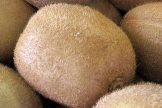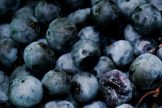
Edible grapes (Vitis vinifera) are vigorous deciduous woody vines native to Europe, northern Africa, and western Asia. They climb by means of tendrils, which wrap around objects to support the weight of the vine. Grapes are well suited to hot, dry conditions and full sun. Cultivated grapes have hermaphrodite flowers (both male and female) and are therefore self-fertile, they do not need a second plant as a pollinator. The flowers are pollinated by wind, insects and are also self-pollinated, developing into dense bunches of berries which we refer to as grapes.
Cultivated edible grape varieties are classified as either table (eating) grapes, which are sweet and have a pleasant flavour, or wine grapes which are too tart to eat due to their high acidity. A few, most notably the Muscats, cross over and can be used as both. Grapes can vary in colour from almost black through to green, red, and amber, and they may be seedless or contain seed. They can be use in a variety of ways, eaten raw, dried, used for making grape juice, wine, jams and jellies, and grape seed oil. Excellent on a cheese board, fun halved and frozen as an ice replacer in drinks.
Depending on the variety, the harvest period for grapes can range from mid-January for the very earliest of varieties all the way through to mid-May for the latest season grapes.
Being fast growing climbers, grape vines make great screening plants. They do need some kind of support to climb onto, though the support can be as simple as a trellis which consists of two posts with some wires strung across them. Grapes can be grown across the north or west sides of a house to provide summer shade and then allow the winter sun through after leaf fall in autumn. They’re also an outstanding climber to grow over a pergola to create a nice cool shaded spot to sit under in the peak of summer.
Growing grapes is relatively easy, they require a warm, full-sun position, with deep, moderately fertile soil. Grapes can tolerate a wide range of soil types from sandy soils to clay soils and will grow in soils of high or low fertility. They prefer soil of a neutral pH (around pH 7.0), though they can tolerate soil pH in the range of 4.5 – 8.5, which is acidic to alkaline, though grape vines grown in soils above pH 7.3 (alkaline) are prone to iron chlorosis as the alkalinity reduces the availability of the micronutrient iron.
There is some maintenance involved in growing grapes, they do require annual winter pruning and spraying with copper or lime sulphur fungicide, but beyond that once-a-year task, they’re quite easy to grow and look after. Grapes are deep rooted (but the roots are not invasive) which makes them drought tolerant once established, though it’s important to keep them moist during summer to produce the fullest fruit.
Grapes fruit on new seasons growth which rises from buds on the previous year’s canes (year-old wood), but they spend the first year putting their energy into sending their roots deep into the ground and putting on vertical growth. Production starts in the second year, and decent harvests are produced by the third year. Most varieties will take around 4-5 years to reach full production, and the longer the length the vine grows, the more fruit it produces.
If you’re looking to buy a grapevine, the best time to purchase one is during the winter bare-root season when there is the greatest range of grape varieties available.
Grape Season
The harvest season for grapes runs from November (very early season), peaks in February (mid season) and ends in May (very late season).
Planting your grape
When: The best time to plant your grapevine is anytime from the winter bare-root season through to springtime, as this gives the plant some growing time to spread its roots out establish itself before it faces the summer heat. The next best time would be in the milder autumn weather once the extreme heat has passed.
Where: Grapevines prefer a location with full sun, good air circulation, and deep well-drained soil for healthy growth and good fruit production.
Shallow soils, and soils which do not drain well should be amended to increase drainage otherwise the roots will stay too damp, which will lead to fungal diseases.
If planting more than one grape vine, make sure that they are spaced at least one metre apart or more.
Since grapevines are climbers, they need a structure to climb on. Make sure that you have a support in place for the grapevine to grow onto before planting it in the ground.
How: It is important to properly prepare the soil before planting, this is general good gardening practice which will prevent problems later on. The goal of soil preparation is to break up and loosen any compacted soils, increase moisture retention in sandy soils, and replenish soil nutrients to encourage plant growth and vigour.
• To prepare the soil for planting the grapevine, loosen the soil and mix in compost and cow manure, adding a maximum of 1/3 mixture of compost and cow manure to 2/3 soil.
• Dig a hole at least twice the width of the root ball near the base of the support structure and plant the vine. Backfill over the roots, firm down and water in well.
It’s a good practise to water in any newly planted plants with seaweed extract, as it contains plant growth stimulants which promote root growth, assisting the plant to establish itself quicker.
Feeding is important for plant growth, so if you didn’t apply any cow manure during soil preparation, you can sprinkle a handful of general purpose fertilizer at a distance of 30cm (1 foot) from the base of the vine a few weeks after planting.
Pruning and training your grapevine
Grapes are produced on the current season’s growth, and are pruned heavily each winter when dormant to produce the next season’s fruiting wood. There are two systems of pruning grapevines, cane pruning and spur pruning, which you use depends on the variety of grape.
Why two systems? The more fertile grape varieties will fruit on new growth growing closer to the base of the year-old cane, and these are usually spur pruned. The less fertile grape varieties will only produce on new growth originating from buds further down the year-old cane, and must therefore be cane pruned, which is a bit more fiddly technique. It’s important to note that some grape varieties can be pruned using either technique. Also, spur-pruned grape varieties can be came pruned for slightly greater yields.
For spur pruned grape varieties (see below), select two canes and train horizontally over wires or another horizontal support. This will form permanent framework canes. Once these canes are trained horizontally, they should start to produce canes from the buds along the length of this cane. These will form the spurs.
Cane-pruned grape varieties
These produce fruit on the current season’s growth on one year wood towards the end of the cane. Cane-pruned grape varieties include Sultana, Carina Currant, Crimson Seedless, Menindee Seedless, Muscat Gordo, Red Globe, Ruby Seedless, and Thompson Seedless.
Establishing a framework for cane-pruned grapes
After a grapevine been growing for a year to establish itself and gain some height, it needs to be pruned to the required shape to develop a framework – a trunk and branches suitable for cane pruning.
The first step to developing the framework is to allow one cane to grow up the support to the desired height and prune it back above bud. Branches will then form from the bud below the pruning cut and the buds below it.
For cane-pruned varieties (see below), select four canes as the current year’s fruiting canes.
Yearly pruning of cane-pruned grapes
In cane-pruning, four canes are selected to produce fruit, and these are renewed every year.
To cane prune a grape vine
1. Prune out the canes that produced the previous year’s crop. These older canes can be identified by the bark colour, which tends to be greyish in colour and rougher in texture, as compared to the newer smooth reddish-bronze canes (which grow from older fruiting canes).
2. Select two new healthy canes on either side of the trunk as the new fruiting canes and tie them to the trellis support wires.
3. Select a new cane on either side of the trunk as a renewal spur and prune them back to 1 or 2 buds. The renewal spurs will produce canes which may also be selected as next year’s canes.
4. Remove all other canes from the vine.
5. Shorten the four new canes to the desired number of buds, this will depend on the grape variety. Most varieties are pruned back to 8-16 buds from the base (not including the bud at the base).
Spur-pruned grape varieties
These produce fruit on the current year’s growth from permanent spurs. Spur pruned grape varieties include Autumn Royal, Black Muscat, Blush Seedless, Cardinal, Dawn Seedless, Early Muscat, Flame Seedless, Italia, Marroo Seedless, Muscat Hamburg, Purple Cornichon and Ribier.
Establishing a framework for spur-pruned grapes
After a grapevine been growing for a year to establish itself and gain some height, it needs to be pruned to the required shape to develop a framework – a trunk and branches suitable for cane pruning.
The first step to developing the framework is to allow one cane to grow up the support to the desired height and prune it back above bud. Branches will then form from the bud below the pruning cut and the buds below it.
For spur-pruned varieties, select two canes as permanent lateral arms, one on either side of the trunk, and tie them back to the horizontal wires of a trellis or frame of a pergola. Once these canes are trained horizontally, they should start to produce canes from the buds along the length of this cane. These will form the spurs.
Yearly pruning of spur-pruned grapes
In spur pruning, new canes are selected to form spurs and pruned back to two buds. These two buds will then produce two fruiting canes. These spurs are renewed every year.
To spur prune a grape vine
1. Prune out the canes that produced the previous year’s crop. These older canes can be identified by the bark colour, which tends to be greyish in colour and rougher in texture, as compared to the newer smooth reddish-bronze canes (which grow from older fruiting canes).
2. Select new canes to be cut back to form the new spurs. Prune back these canes back to two buds from the base (not including the bud at the base). Select healthy growth that is spaced evenly along the length of the framework cane, and usually buds are selected that face upwards. Keep the spacing at approximately 15-20cm apart.
3. Prune off all other growth from the framework canes.
Each year, all new growth from the spurs needs to be shortened to the second bud.
Watering and fertilising
Grapevines are drought tolerant but need regular watering during the growing and fruiting season, for optimum production. Watering is usually necessary from early November to late.
To conserve soil moisture and reduce water needs, ensure that the soil around the grapevine is mulched during the summer months.
Fertilize with a slow release balanced fertilizer in spring, if you use manure (which mainly contains nitrogen and phosphorus) it is best to supplement it with potassium (potash) or seaweed extract (which is rich in potassium) during flowering. Grapes don’t need much fertiliser, so don’t overdo it, and don’t use fertilizers that are too high in nitrogen.
Pests and diseases
Grapevines can be prone to fungal problems in humid areas, so avoid wetting the foliage when watering to minimise the risk of disease.
Fungal diseases are best prevented by using a copper-based fungicide or lime-sulphur when the grapevine is dormant, spray according to the product’s directions.
When in leaf, grapevines in high humidity can be affected by powdery mildew, a greyish-white powder covering the leaf surface. This is a fungal disease which can be treated by spraying with potassium bicarbonate (which goes under the product name of Eco-fungicide), or by using a spray of bicarbonate of soda (which is not as effective) – one teaspoon of bicarbonate of soda into one litre of water and add one drop of detergent and one drop of vegetable oil to make it stick to the leaves.
Some gardeners believe that spraying the vine with a bit of seaweed extract (Seasol, Multicrop etc, diluted to foliar feed concentration) can help prevent fungal problems.
If you want to go all the way with fungicide treatment and do what organic farmers do, you can apply wettable sulphur fortnightly from mid-September to late December. Growers usually change over to from wettable sulphur to sulphur dust once the fruit has set. Do not apply sulphur on days when the temperature is to be 30°C or higher.
One pest which can affect grapes is the grape leaf blister mite, which causes raised blisters on a grape leaf which are often mistaken as a fungal disease. The damage is mainly cosmetic, the leaves may look unsightly, but fruit production is not affected. Spraying with lime sulphur at bud-swell should adequate control this pest.
Phylloxera
Now, a serious word of warning with regards to grapes. Due to a nasty little pest of both edible and ornamental grape vines – Phylloxera – movement of grape vines is seriously restricted in Victoria. Before you take your grape vine, vine cuttings, or ornamental grape vine for a ride in the car from one part of the state to another, make sure you are well aware of the Phylloxera exclusion zones that exist throughout Victoria.




